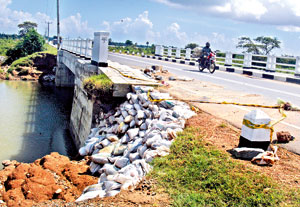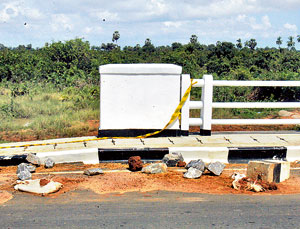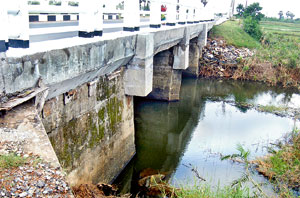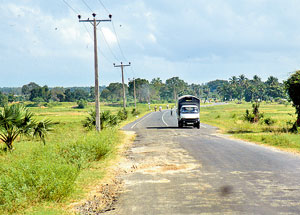What is easily Sri Lanka’s showpiece highway that cost the taxpayer Rs 100,000 per metre or over four hundred million rupees for just four kilometres is in rack and ruin just two months after it was constructed.
This stretch of road from Chenkkaladi to Maha Oya is already broken in several places. Yellow warning tapes are displayed in those areas by the Road Development Authority (RDA) to warn motorists of the danger zones. The recent floods that occurred twice in the area have made matters worse. Four bridges within this stretch of road have been damaged. The luminous white road markers near the bridges have fallen into the streams nearby.
 |
| Temporary solution to a broken bridge - two months after construction. Pix by Ranjith Perera |
 |
| Yellow tape demarcating the danger
zone for motorists. |
 |
| A newly reconstructed bridge on an old base |
 |
| Part of the reconstructed road and the road to be reconstructed: Picture shows that the width of the road has not been widened much in the
newly done up section. |
On a visit to this stretch of the road, which opposition United National Party (UNP) parliamentarian Dayasiri Jayasekara described could have been paved with gold for the cost that was incurred, runs through lush paddy fields and clear streams. Photographer Ranjith Perera and I spoke to residents living in the area. One of them, Sabaratnam Jeeva, a businessman, said the asphalt-laid road was constructed on top of what was then a tarred surface. “I think there is something wrong with the construction work. It was only the newly constructed bridges along the stretch that were damaged by the floods. The older bridges, seven of them, remained intact,” he added. He pointed out that the debris from the demolished bridges were thrown close to the new one forcing water to collect. The overflow was so fast, it damaged the new bridges.
Jayasekera, the Kurunegala District MP raised a question in Parliament over this stretch of the road. In reply, Minister Dinesh Gunawardena said the four kilometre stretch had cost the government Rs 411.87 million. He listed four companies who had bid and the company which had been awarded contracts for the four- kilometre stretch as part of an Asian Development Bank funded road rehabilitation programme. The photographs on this page tell the story of the state of the road.
S. Meihanandan, Additional Director-General of the Road Development Authority blamed the “abnormal, unprecedented floods” for the damage to the road and bridges. That is just two months after it was opened for traffic in December last year. Arguably the most expensive road stretch in Sri Lanka is located between kilometre posts 280 and 284.
Mr. Meihanandan said costs were high because eleven bridges had to be reconstructed. “Improving the condition of the road according to RDA standards,” he said, “would have cost around Rs 52 to Rs 55 million per kilometre. That was without the cost of the bridges.” He said RDA standards would have included widening of the road traffic lanes of 3.5 metres each in addition to a 1.5 metre lane for bicycles. “We follow those standards whenever we are rehabilitating a road,” he said. However, when observed, we saw that the road was not significantly widened after the rehabilitation.
Within this four-kilometre stretch, an old and dilapidated bridge remains. V. Navaratnam, a former state sector engineer now engaged in a road development project said, the costs of a project depends on “many aspects such as materials used for the construction and how much widening is done.” The length of bridges, structures and foundation also add to the cost.
However, Mr. Navaratnam said the reconstruction of a kilometre stretch of the A-4 and A-15 roads cost only Rs 38 million per kilometre. That included the construction of minor bridges, culverts and surfacing the road with asphalt. “The soil condition and depth of the foundation too matters when it comes to construction cost. He said the road projects cost Rs 3.8 billion for 100 kilometres.
M. Ismail Nawaz, a farmer who drives along this road to his paddy field in Eravur said it took nearly nine months to complete the four kilometre stretch. N. Ramachandra, a paddy farmer in the area said the road was built on the existing foundation. He said most farmers use this road to transport their produce. |





